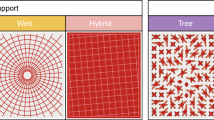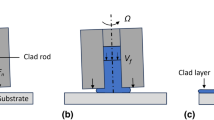Abstract
Press-braking bending is usually performed after face milling to obtain the specified curvature of variety mechanical parts, which is widely applied in the aircraft manufacturing. However, the residual stress on the surface layer of the workpiece resulting from the milling process can significantly impact the subsequent bending forming. This paper aims to investigate the influences of surface residual stress caused by milling operation on press-braking bending both analytically and experimentally. An analytical model for springback prediction based on plane strain assumption is proposed using the material model of Mises yield criterion and Swift exponential hardening law, while also considering the effects of milling-induced residual stress. Three different levels of residual stress are introduced into the test plates through milling operation at varying cutting speed. The analytical results are then compared with bending experiments conducted on 7050-T7451 Al-alloy plates. Results show that the accuracy of the predicted contour is improved when surface residual stress is taken into account. Furthermore, the influence of surface residual stress on springback is discussed. It is revealed that surface tensile residual stress increases springback, while surface compressive residual stress contributes positively to the final shape of bent specimens.










Similar content being viewed by others
References
Yan Y, Wan M, Wang HB, Huang L (2010) Optimization of press bend forming path of aircraft integral panel. T Nonferr Metal Soc 20(2):294–301
Kuroda K, Kawakami T, Okui T, Akiyama M, Kiuchi M (2015) Influential factor to dimensional precision of cold-drawn tubes. P I Mech Eng B-J Eng 229(1):100–109
Panthi SK, Ramakrishnan N, Ahmed M, Singh SS, Goel MD (2010) Finite element analysis of sheet metal bending process to predict the springback. Mater Design 31(2):657–662
Munroe J, Wilkins K, Gruber M (2000) Integral airframe structures (IAS)---validated feasibility study of integrally stiffened metallic fuselage panels for reducing manufacturing costs. Boeing Commercial Airplane Group, Seattle, Washington
Miranda SS, Barbosa MR, Santos AD, Pacheco JB, Amaral RL (2018) Forming and springback prediction in press brake air bending combining finite element analysis and neural networks. J Strain Anal Eng 53(8):584–601
Froitzheim P, Stoltmann M, Fuchs N, Woernle C, Flügge W (2020) Prediction of metal sheet forming based on a geometrical model approach. Int J Mater Form 13(5):829–839
Panthi SK, Ramakrishnan N (2011) Semi analytical modeling of springback in arc bending and effect of forming load. T Nonferr Metal Soc 21(10):2276–2284
Garcia-Romeu ML, Ciurana J, Ferrer I (2007) Springback determination of sheet metals in an air bending process based on an experimental work. J Mater Process Tech 191(1):174–177
Yan Y, Wang HB, Li Q (2015) The inverse parameter identification of Hill 48 yield criterion and its verification in press bending and roll forming process simulations. J Manuf Process 20:46–53
Kim S, Stelson KA (1988) Finite element method for the analysis of a material property identification algorithm for pressbrake bending. J Manuf Sci E 110(3):218–222
Esat V, Darendeliler H, Gokler MI (2002) Finite element analysis of springback in bending of aluminium sheets. Mater Design 23(2):223–229
Zhang DJ, Cui ZS, Ruan XY, Li YQ (2007) An analytical model for predicting springback and side wall curl of sheet after U-bending. Comp Mater Sci 38(4):707–715
Anokye-Siribor K, Singh UP (2000) A new analytical model for pressbrake forming using in-process identification of material characteristics. J Mater Process Tech 99(1):103–112
Zhao J, Yin J, Ma R, Ma LX (2011) Springback equation of small curvature plane bending. Sci China Technol Sc 54(9):2386–2396
Mohammadi SV, Parsa MH, Aghchai AJ (2014) Simplified springback prediction in Al/PP/Al sandwich air bending. J Sandw Struct Mater 17(3):217–237
Choudhury IA, Ghomi V (2014) Springback reduction of aluminum sheet in V-bending dies. P I Mech Eng B-J Eng 228(8):917–926
Huang K, Yang WY (2016) Analytical modeling of residual stress formation in workpiece material due to cutting. Int J Mech Sci 114:21–34
Ma Y, Feng PF, Zhang JF, Wu ZJ, Yu DW (2016) Prediction of surface residual stress after end milling based on cutting force and temperature. J Mater Process Tech 235:41–48
Yang D, Liu ZQ, Ren XP, Zhuang P (2016) Hybrid modeling with finite element and statistical methods for residual stress prediction in peripheral milling of titanium alloy Ti-6Al-4V. Int J Mech Sci 108-109:29–38
Agrawal S, Joshi SS (2013) Analytical modelling of residual stresses in orthogonal machining of AISI4340 steel. J Manuf Process 15(1):167–179
Weiss M, Rolfe B, Hodgson PD, Yang CH (2012) Effect of residual stress on the bending of aluminium. J Mater Process Tech 212(4):877–883
Abvabi A, Rolfe B, Hodgson PD, Weiss M (2016) An inverse routine to predict residual stress in sheet material. Mater Sci Eng A 652:99–104
Abvabi A, Rolfe B, Hodgson PD, Weiss M (2015) The influence of residual stress on a roll forming process. Int J Mech Sci 101-102:124–136
Lin C, Peng Y, Sun JL (2013) Theoretical analysis on springback in bending considering the initial residual stress. Eng Mech 30(9):28–33
Singh A, Agrawal A (2015) Investigation of surface residual stress distribution in deformation machining process for aluminum alloy. J Mater Process Tech 225:195–202
Huang XM, Sun J, Li JF (2015) Finite element simulation and experimental investigation on the residual stress-related monolithic component deformation. Int J Adv Manuf Tech 77(5-8):1035–1041
Wang M, Liu YN, Sun GZ (2017) Influence of initial residual stress and cutting stress on machining deformation of thin-walled parts. J Beijing Univ Technol 43(8):1141–1147
Spence TW, Makhlouf MM (2015) The effect of machining-induced residual stresses on the creep characteristics of aluminum alloys. Mater Sci Eng A 630(4):125–130
Lam ACL, Shi ZS, Lin JG, Huang X (2015) Influences of residual stresses and initial distortion on springback prediction of 7B04-T651 aluminium plates in creep-age forming. Int J Mech Sci 103:115–126
Li WD, Ma LX, Wan M, Peng JW, Meng B (2018) Modeling and simulation of machining distortion of pre-bent aluminum alloy plate. J Mater Process Tech 258:189–199
Quach WM, Teng JG, Chung KF (2006) Finite element predictions of residual stresses in press-braked thin-walled steel sections. Eng Struct 28(11):1609–1619
Quach WM, Teng JG, Chung KF (2010) Effect of the manufacturing process on the behaviour of press-braked thin-walled steel columns. Eng Struct 32(11):3501–3515
Li Y, Shi ZS, Lin JG, Yang YL, Saillard P, Said R (2018) Effect of machining-induced residual stress on springback of creep age formed AA2050 plates with asymmetric creep-ageing behavior. Int J Mach Tool Manu 132:113–122
Li JG, Wang SQ (2017) Distortion caused by residual stresses in machining aeronautical aluminum alloy parts: recent advances. Int J Adv Manuf Tech 89(1-4):997–1012
Huang XM, Sun J, Li JF, Han X (2013) Xiong QC (2013) An experimental investigation of residual stresses in high-speed end milling 7050-T7451 aluminum alloy. Adv Mech Eng 2:435–447
Mohammadpour M, Razfar MR, Saffar RJ (2010) Numerical investigating the effect of machining parameters on residual stresses in orthogonal cutting. Simul Model Pract Th 18(3):378–389
Tang ZT, Liu ZQ, Ai X (2008) Experimentation on the superficial residual stresses generated by high-speed milling aluminum alloy. China Mech Eng 19:699–703
Kim H, Nargundkar N, Altan T (2007) Prediction of bend allowance and springback in air bending. J Manuf Sci E 129(2):342–351
Swift HW (1952) Plastic instability under plane stress. J Mech Phy Solid 1:1–18
Zhang ZT, Hu SJ (1998) Stress and residual stress distributions in plane strain bending. Int J Mech Sci 40(6):533–543
Zhang M, Tian XT (2020) Residual stresses and strains analysis in press-braking bending parts considering multi-step forming effect. P I Mech Eng B-J Eng 234(4):788–800
Yang X, Choi C, Sever NK, Altan T (2016) Prediction of springback in air-bending of advanced high strength steel (DP780) considering Young′s modulus variation and with a piecewise hardening function. Int J Mech Sci 105(1-2):266–272
Li H, Yang H, Song FF, Zhan M, Li GJ (2012) Springback characterization and behaviors of high-strength Ti–3Al–2.5V tube in cold rotary draw bending. J Mater Process Tech 212(9):1973–1987
Shen W, Yan RJ, Li SY, Xu L (2018) Spring-back analysis in the cold-forming process of ship hull plates. Int J Adv Manuf Tech 96:2341–2354
Abvabi A, Rolfe B, Hodgson PD, Weiss M (2014) Effect of temper rolling on final shape defects in a V-section roll forming process. Am Institute Phys Conf Ser 1567(1):896–899
Parsa MH, Mohammadi SV, Mohseni E (2015) Thickness change and springback of cold roll bonded aluminum/copper clad sheets in air bending process. P I Mech Eng B-J Eng 231(4):675–689
Funding
This work is funded by the Natural Science Basic Research Project of Shaanxi Province, China (grant number 2022JQ-526); the Key Laboratory of Road Construction Technology and Equipment of MOE, Chang’an University (grant number 300102252508); and the Doctoral Foundation Project of Xi’an Polytechnic University (grant number BS202121).
Author information
Authors and Affiliations
Contributions
All authors contributed to the study conception and design. Material preparation, data collection, and analysis were performed by M.Z. and D.L. The first draft of the manuscript was written by M.Z., and all authors commented on previous versions of the manuscript. All authors read and approved the final manuscript.
Corresponding author
Ethics declarations
Competing interests
The authors declare no competing interests.
Additional information
Publisher’s Note
Springer Nature remains neutral with regard to jurisdictional claims in published maps and institutional affiliations.
Rights and permissions
Springer Nature or its licensor (e.g. a society or other partner) holds exclusive rights to this article under a publishing agreement with the author(s) or other rightsholder(s); author self-archiving of the accepted manuscript version of this article is solely governed by the terms of such publishing agreement and applicable law.
About this article
Cite this article
Zhang, M., Li, D. Theoretical and experimental investigation of the deformation shape in press-braking bending considering surface residual stresses induced by milling operation. Int J Adv Manuf Technol 131, 1059–1069 (2024). https://doi.org/10.1007/s00170-024-13089-7
Received:
Accepted:
Published:
Issue Date:
DOI: https://doi.org/10.1007/s00170-024-13089-7




